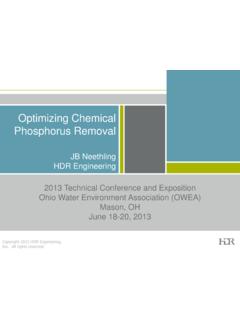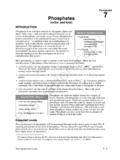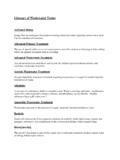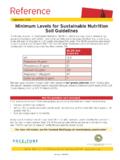Transcription of (2000) Relating Soil Phosphorus Indices to Potential ...
1 Relating Soil Phosphorus Indices to Potential Phosphorus Release to WaterP. S. Hooda,* A. R. Rendell, A. C. Edwards, P. J. A. Withers, M. N. Aitken, and V. W. TruesdaleABSTRACTR elationships between soil test Phosphorus (STP) and release ofP in surface and subsurface runoff are needed to help identify sourceareas for implementing management strategies to limit P loss to determine whether soil P release could be predicted either bySTP values, sorption-desorption Indices , or the degree of soil satura-tion with Phosphorus (DSSP), 11 sites with contrasting chemical prop-erties and management histories were sampled from long-term fieldtrials in the UK.
2 Each site offered up to three treatments, resultingin a total of 29 soil samples. The results showed that the amount ofP desorbed using a successive dilution procedure had no relationshipwith either total soil P content or P sorption capacity. The mostsignificant property was the extent of P saturation. There was littledesorption for DSSP values below 10%; above this point, the amountof P desorbed increased linearly with the DSSP. Five STP methods(Olsen, Mehlich-3, acidified ammonium oxalate-oxalic acid, Fc2O,-coated paper strip, and distilled water) were compared to predict theireffectiveness in predicting Potential P release to water.
3 While STPvalues obtained using acidified ammonium oxalate proved to be leasteffective, those extracted with water correlated best with the amountof P desorbed, accounting for 96% of the variability in differential Prelease from the transport in agricultural runoff can ac-celerate eutrophication in surface waters ( Hooda, Rendell, and Truesdale, School of Biologicaland Molecular Sciences, Oxford Brookes Univ., Oxford OX3 OBP,UK; Edwards, Macaulay Land Use Research Institute, Craigie-buckler, Aberdeen AB15 8QH; Withers, ADAS Bridgets, Win-chester SO21 1AP; and Aitken, Scottish Agricultural College,Auchincruive, Ayr KA6 5HW, UK.)
4 Received 11 Aug. 1999. '''Corre-sponding author in J. Environ. Qual. 29:1166-1171 (2000).and Menzel, 1987). The loss of P from agricultural soilsin surface runoff or subsurface drainage therefore canhave potentially serious implications for water magnitude of P loss from soils is influenced byvarious factors, including land use (Nearing et al., 1993),soil type (Miller, 1979; Hooda et al., 1997), soil P (Heck-rath et al., 1995; Pote et al., 1996; Hooda et al., 1999),amount and intensity of rainfall (Edwards and Daniel,1993), and time and rate of fertilizer and manure appli-cation (Edwards and Daniel, 1993; Hooda et al.
5 , 1999).However, soil P is the underlying source of P in agricul-tural runoff, and increases in soil P status due to surplusP inputs therefore represent a long-term eutrophica-tion Potential loss of P from soils has been assessedusing STP methods ( , Olsen, Mehlich-3, and aceticacid) that were originally designed to estimate plantavailable P (Miller et al., 1993). A certain degree ofrelationship has been demonstrated to exist betweenSTP and the loss of P in runoff. These relationshipsgenerally have been tested for situations having similarsoil type (Heckrath et al., 1995; Austin et al., 1996;Pote et al., 1996; Hooda et al.
6 , 1999). However, recentresearch suggested that an approach based upon STPmight lead to ambiguous conclusions, particularly whendifferent soils are compared, due to differences in thenature of P-adsorbing surfaces. For example, Sharpley(1995), assessing P loss from a group of 10 soils amendedwith poultry litter, showed that two soils of 200 mg kg"1 Abbreviations: STP, soil test Phosphorus ; DSSP, degree of soil satura-tion with Phosphorus ; DRP, dissolved reactive Phosphorus ; PSI, phos-phorus sorption index; PSM, Phosphorus sorption ET AL.: Phosphorus RELEASE TO WATERT able 1. Land use, range of P inputs, and classification of the soils from 11 long-term field seriesLand use and management detailsRange of P Classificationkg P ha-1 yr-1 StiflingGrassland; fertilized and/or cattle slurry applied45-75 Silty clay loamTypic HaplaqueptDessGrass-barley rotation; no fertilizer or fertilized0--50 Sandy clay loamAlflc FragiortodInschGrass-barley rotation; no fertilizer or fertilized0-40 Sandy loamTypic CryochreptFoudlandGrass-barley rotation; no fertilizer or fertilized0-40 Sandy loamTypic FragiortodStonehavenGrass-arable rotation; no fertilizer or fertilized0-40 Sandy loamTypic CryochreptBromyardCereals.
7 No fertilizer, fertilized, or cattle slurry applied0-82 Silty clay loamTypic HapludalfCuckneyCereals; fertilized, no fertilizer, or poultry litter applied0-300 Loamy sandTypic UdipsammentBecclesCereals; fertilized or no fertilizer0-44 Clay loamTypic AlbaqualfPeebles-1 Grassland; no fertilizer or sewage sludge applied0-130 Sandy loamTypic DystrochreptCapringtonGrassland; no fertilizer or sewage sludge applied0-130 Clay loamTypic HaplaqueptPeebles-2 Grassland; sewage sludge applied115-355 Sandy clay loamTypic HumaqueptMehlich-3 P supported a dissolved reactive Phosphorus (DRP) concentration of mg -1 and mg et al. (1997), monitoring P outputs in six agricul-tural catchments in Scotland, provided a more tangibleevidence of soil extractable P being an ambiguous indexof assessing P loss in agricultural runoff.
8 The P lossesin runoff from well-drained podzols were more thanfour times smaller than those from the poorly drainedgleysols, despite the fact that the former group of soilshad four times larger M acetic acid soil extractable-P tests might not be expectedto provide a good estimation of the P loss in runoff,because these (agronomic) tests extract a large pool P accessible to growing plants rather than the P fractionthat might be potentially released to draining of the ease with which P is desorbed fromdifferent soils and the factors that affect the processtherefore might help better assess the soils that arepotentially vulnerable to P loss to water. For example,the amount of P that can be easily desorbed is morelikely to be dependent on the DSSP than the extract-able-P content, as the soil-specific soil-phosphate bind-ing strength will decrease with increasing P loading (Ry-den and Syers, 1977; Hooda et al.)
9 , 1999). A measure ofthe DSSP therefore might provide a better estimate ofthe Potential for P loss to water than soil total- andextractable-P or P sorption capacity (Sharpley, 1995);however, this approach has not been fully paper reports a study designed specifically totest the relationships between a range of soil test meth-ods with potentially desorbable P using soils collectedfrom long-term field trials receiving fertilizer, cattleslurry, or sewage sludge as the source of P inputs. Thespecific objectives of the work were to (i) examine therelationship between soil total P, sorption-desorptionindices, DSSP, and the amount of P that can be poten-tially released to water and (ii) determine which of thecommonly used soil tests best predict Potential loss ofP to water, particularly when compared across a rangeof AND METHODSLand Use, Soil Characteristics, and AnalysesA range of soils with contrasting chemical properties andmanagement histories under both grassland and arable farm-ing systems were collected from 11 long-term field trials fromvarious locations in the UK.
10 The land use, ranges of P inputs,management histories, and classifications of the soils are listedin Table 1. Some of the grassland sites had received cattleslurry or superphosphate or a combination of the two; othershad received P inputs through sewage sludge applications. Thearable sites had either superphosphate, cattle slurry, or poultrylitter as the source of P. Each soil offered up to three treat-ments, resulting in a total of 29 soil samples. Representativesurface samples (0-20 cm) of the 11 sites (Table 1) were lected, air-dried, gently ground, and passed through a 2-ramsieve prior to use in these size distribution, pH, organic matter, and calciumcarbonate equivalent were determined using standard proce-dures given in Rowell (1994).











